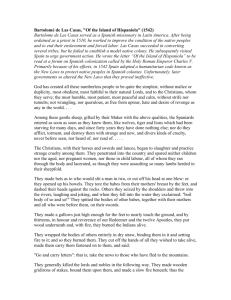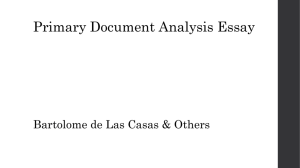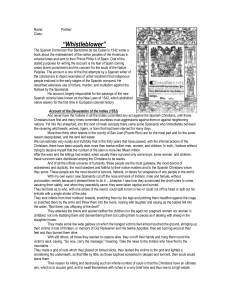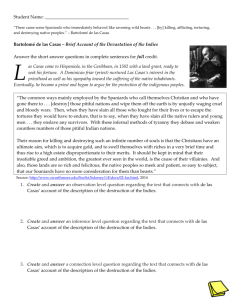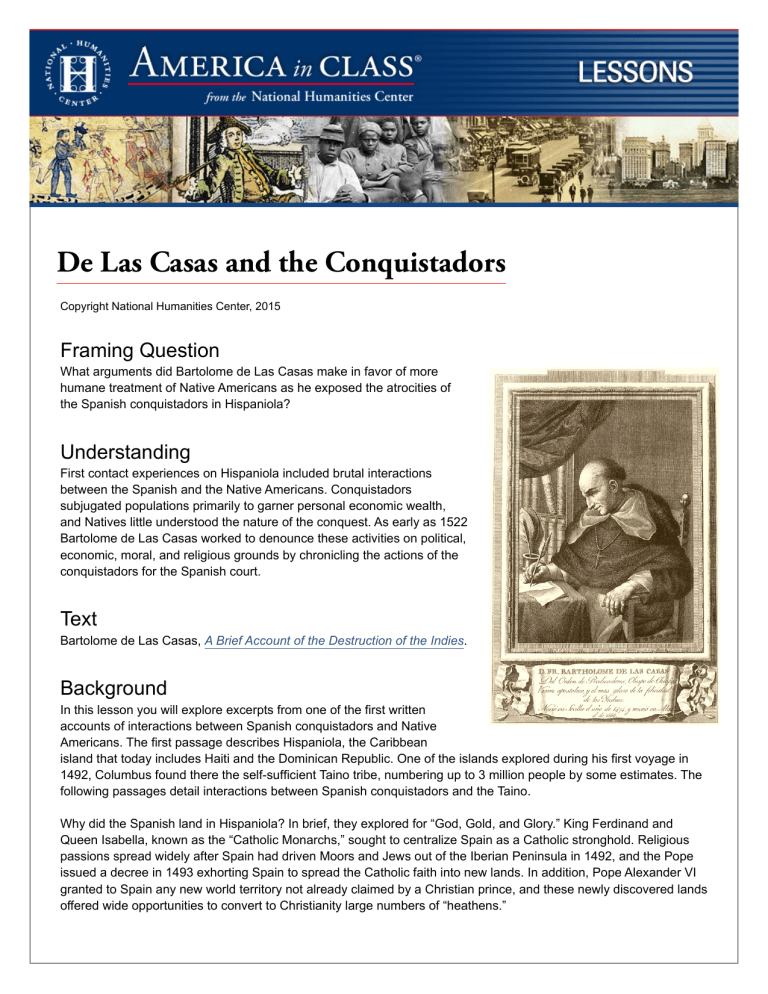
De Las Casas and the Conquistadors Copyright National Humanities Center, 2015 Framing Question What arguments did Bartolome de Las Casas make in favor of more humane treatment of Native Americans as he exposed the atrocities of the Spanish conquistadors in Hispaniola? Understanding First contact experiences on Hispaniola included brutal interactions between the Spanish and the Native Americans. Conquistadors subjugated populations primarily to garner personal economic wealth, and Natives little understood the nature of the conquest. As early as 1522 Bartolome de Las Casas worked to denounce these activities on political, economic, moral, and religious grounds by chronicling the actions of the conquistadors for the Spanish court. Text Bartolome de Las Casas, A Brief Account of the Destruction of the Indies. Background In this lesson you will explore excerpts from one of the first written accounts of interactions between Spanish conquistadors and Native Americans. The first passage describes Hispaniola, the Caribbean island that today includes Haiti and the Dominican Republic. One of the islands explored during his first voyage in 1492, Columbus found there the self-sufficient Taino tribe, numbering up to 3 million people by some estimates. The following passages detail interactions between Spanish conquistadors and the Taino. Why did the Spanish land in Hispaniola? In brief, they explored for “God, Gold, and Glory.” King Ferdinand and Queen Isabella, known as the “Catholic Monarchs,” sought to centralize Spain as a Catholic stronghold. Religious passions spread widely after Spain had driven Moors and Jews out of the Iberian Peninsula in 1492, and the Pope issued a decree in 1493 exhorting Spain to spread the Catholic faith into new lands. In addition, Pope Alexander VI granted to Spain any new world territory not already claimed by a Christian prince, and these newly discovered lands offered wide opportunities to convert to Christianity large numbers of “heathens.” In order to understand the Spanish hunger for gold in the 16th century, Contextualizing Questions one must recognize the Spanish treasure fleet system. Spain at this 1. What kind of text are we dealing with? time had a strong navy but no real industry within the country, and 2. When was it written? so she had to buy all her goods from other nations, making gold and 3. Who wrote it? silver very important. To help fund their naval and colonial activities in 4. For what audience was it intended? the midst of competition with Portugal, the Spanish King and Queen 5. For what purpose was it written? financed Columbus’s voyages to search for trade routes and fresh sources of gold and silver through new colonies. The New World gold and silver mines became the largest source of precious metals in the world, and Spain passed laws that colonists could trade only with Spanish ships in order to keep the gold and silver flowing through Spain. The large flow of treasure to Spain from the capture of the Aztecs (1517), the Incas (1534), and Mexico (1545) sharpened the appetite for gold and silver in Hispaniola. Columbus was soon followed by other explorers seeking glory for themselves as well as for Spain, including Bartolome de Las Casas (1484–1566), author of this text. Las Casas knew Christopher Columbus — his father and brother went with Columbus on his second voyage, and Bartolome edited Columbus’s travel journals. The Spanish King awarded de Las Casas and his family an encomienda, a plantation that included the slave labor of the Indians who lived on it, but after witnessing the brutality of other Spanish explorers to the local tribes, Bartolome gave it up. He became a Dominican priest, spending the rest of his life writing, speaking and encouraging the Christian conversion of the North American natives by peaceful rather than military means. De Las Casas started a mission in Guatemala and wrote several accounts, aimed at the king and queen and members of the royal court, that sought to expose the brutal methods of the conquistadors and persuade Spanish officials to protect the Indians. The excerpts in this lesson are from probably the best known of those accounts, A Brief Account of the Destruction of the Indies, published in 1552. What were the effects of his work? While the Pope had granted Spain sovereignty over the New World, de Las Casas argued that the property rights and rights to their own labor still belonged to the native peoples. Natives were subjects of the Spanish crown, and to treat them as less than human violated the laws of God, nature, and Spain. He told King Ferdinand that in 1515 scores of natives were being slaughtered by avaricious conquistadors without having been converted. He sought to protect the souls of Spain and the conquistadors against divine retribution for the destruction of the native populations by awakening the moral indignation of Christian men to counter the growing tide of barbarism. Between 1513 and 1543 Spain issued several laws attempting to regulate the encomienda system and protect native populations, but enforcement was haphazard and the subjugation of the native populations was already a fact. Nonetheless, through his self-proclaimed goal of bearing witness to the savagery of the Europeans against the simply civility of the indigenous peoples, de Las Activity: Vocabulary Casas became characterized as the conscience of Spanish Learn definitions by exploring exploration. how words are used in context. If the immediate impact of his work was marginal, the long-term influence would be substantial. In the passages excerpted here and throughout A Brief Account, de Las Casas repeatedly asserts that he witnessed the events he is describing and thus bases his argument on the authority of his first-hand testimony. This practice makes his work an early example of empiricism, the idea that arguments and conclusions should be based upon observable fact. Unquestioned today, in the 1500s this was a new concept, for at that time people held that the proof of an argument should be based on the interpretation of texts rather than the concrete experience of an eye witness. De Las Casas’ book describes events he witnessed on the island of Hispaniola. As your read these excerpts think about what the Indian kingdoms were like when the Spanish arrived. How did the Indians initially respond to the Spanish? How did the Spanish respond to the Indians? How does the fact that de Las Casas was an eyewitness to these events lend authority to this account? De Las Casas and the Conquistadors – A Close Reading Guide from America in Class 2 Text Analysis Excerpt 1 In this excerpt de Las Casas speaks of the beginning of Spanish atrocities on the island of Hispaniola. Pay attention to how the Spaniards viewed the inhabitants of Hispaniola, to how the Natives originally viewed the Spanish, and to how the Natives’ perceptions changed. (1) In this Isle, which, as we have said, the Spaniards first attempted, the bloody slaughter and destruction of Men first began: for they violently forced away Women and Children to make them Slaves, and ill-treated them, consuming and wasting their Food, which they had purchased with great sweat, toil, and yet remained dissatisfied too,… (2) and one individual Spaniard consumed more Victuals in one day, than would serve to maintain Three Families a Month, every one consisting of Ten Persons. (3) Now being oppressed by such evil usage, and afflicted with such greate Torments and violent Entertainment [treatment] they began to understand that such Men as those had not their Mission from Heaven; and therefore some of them conceal’d their Provisions and others to their Wives and Children in lurking holes, but some, to avoid the obdurate and dreadful temper of such a Nation, sought their Refuge on the craggy tops of Mountains; for the Spaniards did not only entertain them with Cuffs, Blows, and wicked Cudgelling, but laid violent hands also on the [Taino] Governours of Cities… (4) From which time they began to consider by what wayes and means they might expel the Spaniards out of their Countrey, and immediately took up Arms. (5) But, good God, what Arms, do you imagine? Namely such, both Offensive and Defensive, as resemble Reeds wherewith Boys sport with one another, more than Manly Arms and Weapons. (6) Which the Spaniards no sooner perceived, but they, mounted on generous Steeds, well weapon’d with Lances and Swords, begin to exercise their bloody Butcheries and Strategems, and overrunning their Cities and Towns, spar’d no Age, or Sex…. 1. What did the Spanish do to the Natives? 2. How would you characterize the Spanish treatment of the natives? 3. How did the Natives come to characterize the Spanish? Why? 4. What does this characterization tell us about the original perception of the Natives regarding the Spanish? 5. How did the Natives respond to the Spanish cruelty? De Las Casas and the Conquistadors – A Close Reading Guide from America in Class 3 6. How did the Natives respond to the Spanish violence against them? What were the results? 7. Once the Spaniards realized that the Indians were resisting, what did they do? 8. What tone does de Las Casas create in this excerpt? How does he create that tone? Cite evidence from the text. 9. How does de Las Casas portray the natives in this passage? Cite evidence from the text. 10. How does this portrayal advance de Las Casas’s argument? Excerpt 2 In this excerpt de Las Casas describes one of the kingdoms of Hispaniola, Magua, and gives eye witness descriptions of the kingdom’s geography. Why would he go into such detail? How does this paradisiacal description contrast with the violence of excerpt 1? (7) This Isle of Hispaniola was made up of Six of their greatest Kingdoms, and as many most Puissant Kings, to whose Empire almost all the other Lords, whose Number was infinite, did pay their Allegiance. (8) One of these Kingdoms was called Magua, signifying a Campaign or open Country; which is very observable, if any place in the Universe deserves taking notice of, and memorable for the pleasantness of its Situation; (9) for it is extended from South to North Eighty Miles, in breadth Five, Eight, and in some parts Ten Miles in length; and is on all sides inclosed with the highest Mountains; above Thirty Thousand Rivers, and Rivulets water her Coasts, Twelve of which prodigious Number do not yield in all in magnitude to those famous Rivers, the Eber, Duer, and Guadalquivir*; (10) and all those Rivers which have their Source or Spring from the Mountains lying Westerly, the number [of rivers] whereof is Twenty Thousand are very rich in Mines of Gold; on which Mountain lies the Province of rich Mines, whence the exquisite Gold of Twenty Four Caracts* weight, takes denomination [is identified there]. Notes: Guadalquivir is the second longest river in Spain. Duero is the third longest river in the Iberian peninsula. Ebre is the second longest river in the Iberian peninsula. Twenty Four Caracts (karat) gold is pure gold, containing no other elements. 11. How many kingdoms were located on the island of Hispaniola? De Las Casas and the Conquistadors – A Close Reading Guide from America in Class 4 12. Describe the Kingdom of Magua. What does its name mean? How large is it in square miles? 13. In what ways does de Las Casas compare Magua with Europe? What is the effect of the comparison? 14. In this description, what would be the most important detail for the Spanish King and Queen? Why? 15. What is the effect of de Las Casas providing such a detailed geographic description of the kingdom in this excerpt? 16. In excerpt 1 de Las Casas speaks of Hispaniola overall. In this excerpt he speaks of Magua, a specific kingdom on Hispaniola. What is the effect of shifting his eye witness account from the overall island to a specific kingdom on the island? Excerpt 3 De Las Casas describes the relationship between the Taino and the Spanish. What was that relationship? From this account, how did the Taino value gold? (11) The King and Lord of this Kingdom was named Guarionex, who governed within the Compass of his Dominions so many Vassals and Potent Lords, that every one of them was able to bring into the Field Sixteen Thousand Soldiers for the service of Guarionex their Supream Lord and Soverain, when summoned thereunto. (12) Some of which I was acquainted with. (13) This was a most Obedient Prince, endued with great Courage and Morality, naturally of a Pacifick Temper, and most devoted to the service of the Castilian* Kings. (14) This King commanded and ordered his Subjects, that every one of those Lords under his Jurisdiction, should present him with a Bell full of Gold; (15) but in succeeding times, being unable to perform it, they were commanded to cut it in two, and fill one part therewith, for the Inhabitants of this Isle were altogether inexperienced, and unskilful in Mine-works, and the digging Gold out of them. (16) This Caiu [Guarionex] proferred his Service to the King of Castile, on this Condition, that he [Guarinoex] would take care, that those Lands should be cultivated and manur’d, wherein, during the reign of Isabella, Queen of Castile, the Spaniards first set footing and fixed their Residence, extending in length even to Santo Domingo, the space of Fifty Miles. (17) For he declar’d (nor was it a Fallacie, but an absolute Truth,) that his Subjects understood not the practical use of digging in Golden Mines. (18) To which promises he had readily and voluntarily condescended, to my own certain knowledge, and so by this means, the King would have received the Annual Revenue of Three Millions of Spanish Crowns, and upward, there being at that very time in that Island Fifty Cities more ample Activity: Inferences and spacious than Sevil it self in Spain. Examine the conclusions that de La Note: Castilian – Spanish Castile, even though technically united with Casas draws from his observations. Aragon in 1469, retained a separate political identity until 1516. De Las Casas and the Conquistadors – A Close Reading Guide from America in Class 5 17. Describe Guarionex’s kingdom, including its political structure. Why does de Las Casas describe it as he does? 18. De Las Casas describes King Guarionex as courageous, even tempered, obedient, and moral. What is the effect of this description? 19. What relationship did King Guarionex have with Spain? How did he prove this relationship? 20. Why was the king unable to continue the full measure of gold tribute? 21. Rather than large gold tributes, what alternative for making money did King Guarionex (the Caiu) offer in sentence 16? 22. According to de Las Casas, even at a reduced tribute how much gold could the Spanish King expect to receive each year? 23. If the Taino subjects “understood not the practical use of digging in Golden Mines,” what does that imply about the value of gold in the Taino culture? Excerpt 4 In this excerpt, the Spanish violently respond to the Taino attempt to reduce the gold tribute. De Las Casas relates God-given justice to the atrocities of the Spanish, and reveals the true motivations of the conquistadors. (19) But what returns by way of Remuneration and Reward did they make this so Clement and Benign Monarch, can you imagine, no other but this? (20) They put the greatest Indignity upon him imaginable in the person of his Consort who was violated by a Spanish Captain altogether unworthy of the Name of Christian. (21) He might indeed probably expect to meet with a convenient De Las Casas and the Conquistadors – A Close Reading Guide from America in Class 6 time and opportunity of revenging this Ingominy so unjuriously thrown upon him by preparing Military Forces to attaque him, but he rather chose to abscond in the Province De los Ciquayos (wherein a Puissant Vassal and subject of his Ruled) devested of his Estate and Kingdom, and there live and dye an exile. (22) But the Spaniards receiving certain information, that he had absented himself, connived no longer at his Concealment but raised War against him, who had received them with so great humanity and kindness, and having first laid waste and desolate the whole Region, at last found, and took him Prisoner, who being bound in Fetters was convey’d on board of a ship in order to his transfretation [transportation] to Castile, as a Captive: (23) but the Vessel perished in the Voyage, wherewith many Spaniards were also lost, as well as a great weight of Gold, among which there was a prodigious Ingot of Gold, resembling a large Loaf of Bread, weighing 3600 Crowns; (24) Thus it pleased God to revenge their enormous impieties. …. (25) The Spaniards first set Sail to America, not for the Honour of God, or as Persons moved and merited thereunto by servent Zeal to the True Faith, nor to promote the Salvation of their Neighbours, nor to serve the King, as they falsely boast and pretend to do, but in truth, only stimulated and goaded on by insatiable Avarice and Ambition, that they might for ever Domineer, Command, and Tyrannize over the West-Indians, whose Kingdoms they hoped to divide and distribute among themselves. (26) Which to deal candidly Activity: Review in no more or less intentionally, than by all these indirect wayes to Review the central points of disappoint and expel the Kings of Castile out of those Dominions the textual analysis. and Territories, that they themselves having usurped the Supreme and Regal Empire, might first challenge it as their Right, and then possess and enjoy it. 24. How did the Spanish react when King Guarionex reduced the gold tribute? 25. Based on the Spanish reaction, what can you infer about how they view Guarionex, a king? Why? 26. How did King Guarionex respond to the Spanish? 27. How did the Spanish respond to King Guarionex’s actions? 28. What happened to the ship? How did de Las Casas see this as divine (God-given) justice? De Las Casas and the Conquistadors – A Close Reading Guide from America in Class 7 29. The Spanish kings considered themselves champions of Christendom during this time, with a special responsibility to spread the Gospel and remain in God’s graces. What is the implication of sentence 24, “Thus it pleased God to revenge their enormous impieties?” 30. According to de Las Casas what was the true motivation of the Spanish explorers? 31. If you were a king or queen of Spain who sent the conquistadors to the New World to Christianize natives and ship back gold and silver to Spain, how would you respond to the story detailed here by de Las Casas? Why? De Las Casas and the Conquistadors – A Close Reading Guide from America in Class 8 Glossary victuals: food afflicted: causing suffering obdurate: stubborn, inflexible dreadful: causing fear cudgelling: beating strategems: deceitful plans puissant: powerful rivulets: small streams prodigious: large compass: proper limits vassals: subordinate land holders potent: mighty; powerful endued: endowed pacifick: peaceful, calm proferred: offered condescended: submitted remuneration: pay, reward clement: merciful; pleasant benign: gracious, kind consort: spouse of a king or queen ingominy: public disgrace unjuriously: harmfully, offensively abscond: leave quickly and secretly devested: taken from connived: overlooked desolate: destroyed fetters: chains, shackles ingot: gold or silver brick impieties: lack of reverence goaded: encouraged insatiable: cannot be satisfied avarice: extreme greed candidly: truthfully usurped: overthrown Text • de Las Casas, Bartolome. A Brief Account of the Destruction of the Indies Or, a faithful NARRATIVE OF THE Horrid and Unexampled Massacres, Butcheries, and all manner of Cruelties, that Hell and Malice could invent, committed by the Popish Spanish Party on the inhabitants of West-India, TOGETHER With the Devastations of several Kingdoms in America by Fire and Sword, for the space of Forty and Two Years, from the time of its first Discovery by them. Project Gutenberg, 2007. [http://www.gutenberg.org/cache/epub/20321/pg20321.html] Images • “Fray Bartholomew de Las Casas,” from the portrait drawn and engraved by Enguidanos. http://www.gutenberg.org/ files/23466/23466-h/23466-h.html#fig1 [accessed March, 2015] • Joan Vinckeboons, “Map of the islands of Hispaniola and Puerto Rico,” c. 1639. Library of Congress, Geography and Map Division. http://www.loc.gov/item/2003623402/ [accessed March, 2015] • Histoire Naturelle des Indes, Illustrated manuscript. ca. 1586. Bequest of Clara S. Peck, 1983 MA 3900 (fol. 11v–12) The Morgan Library and Museum, New York. http://www.themorgan.org/collection/Histoire-Naturelle-des-Indes/98 [accessed March, 2015] De Las Casas and the Conquistadors – A Close Reading Guide from America in Class 9
